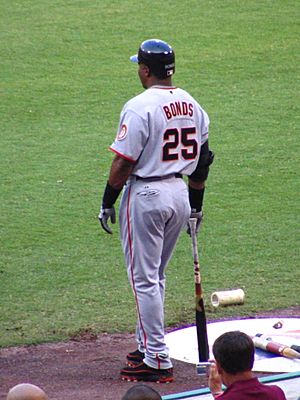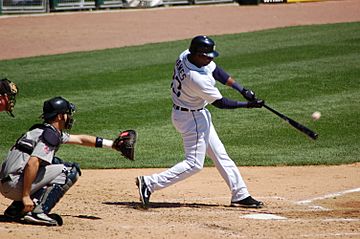Batting (baseball) facts for kids
In baseball, batting is when a player stands at home plate and tries to hit the ball thrown by the other team's pitcher. The goal is to help your team score runs. A batter or hitter is the player whose turn it is to hit. Batters try to get on base, help other players score, or move them closer to scoring. Hitting in baseball is special because it involves spinning your body sideways, which is different from most sports.
Contents
What Batters Try to Do
Batters usually want to get a hit. But their main goal is to avoid getting out and to help their team score runs. There are many ways they can do this:
- They might get a walk if the pitcher throws four pitches outside the strike zone that they don't swing at.
- If there's a runner on third base and fewer than two outs, they can hit a sacrifice fly. This lets the runner on third tag up and score.
- With fewer than two outs and runners on base, they might try a sacrifice bunt. This moves runners forward, even if the batter gets out.
- They could also be hit by a pitch, get on base because of an error by a fielder, or even reach base if the catcher drops a third strike (if first base is empty or there are two outs).
The other team's defense tries to get the batter out. The pitcher tries to throw the ball so the batter either strikes out or can't hit it well. This makes it easier for the defense to get them out.
Being a Successful Batter
Hitting a baseball is one of the hardest things to do in sports. You have to hit a small, fast ball with a thin bat. If a batter gets a hit three out of ten times they try, they have a batting average of .300. This is considered very good!
In Major League Baseball, no one has finished a season with a batting average over .400 since Ted Williams did it in 1941. No player has ever had a lifetime average over .367; Ty Cobb holds the record at .3664.
Today, people often look at a stat called on-base plus slugging (OPS). This stat combines how often a player gets on base (on-base percentage) with how many bases they get per hit (slugging percentage). An OPS near 1.000 means a batter is amazing. Very few players have kept an OPS of 1.000 or higher throughout their career.
Batting Strategy
Batters have different ways of hitting. Some are aggressive and might swing at the very first pitch. Pitchers often try to throw a strike right away.
Other batters are more patient. They wait for the right pitch, hoping to make the pitcher throw more pitches. This can tire the pitcher out. Generally, batters who focus on just making contact are more aggressive. Power hitters, who aim for extra-base hits, might wait for a pitch they can really hit hard.
Warming Up to Bat
Before a game, every baseball player has a special way to warm up. Teams often warm up together, especially at younger levels. This helps batters get ready to hit. A common drill is the "Tee Drill," where you hit a ball off a batting tee. This helps you fix any hitting problems.
Players also use special tools in the "on deck circle" to warm up. These tools can help them swing the bat faster. They might swing multiple bats, or bats with extra weight like a doughnut ring. Players feel that swinging a heavier bat makes their normal bat feel lighter, helping them swing faster. This can be both a mental and physical boost.

The Batting Order
The lineup or batting order is a list of the nine players on a team. It shows the order they will bat during the game. The only way to change this order during a game is by substituting a player. Once the ninth player bats, the first player bats again. This is called the top of the order.
Lineups are planned to help the team score runs. Players are placed in different spots in the lineup based on their skills. No matter where they are, all batters are trying to create runs for their team.
The player currently hitting is called at the plate, at bat, or up to bat. The next player to bat waits in a special area called the on deck circle. This player is said to be on deck. The player after the "on deck" batter is called in the hole.
Types of Hitters
- Power hitters: These batters, also called sluggers, hit the ball very hard. They often hit home runs and other extra-base hits. However, they might also strike out more often than other hitters.
- Pull Hitters: These batters tend to hit the ball to the same side of the field as the side of the plate they are standing on.
- Opposite Field Hitters: These batters can wait a tiny bit longer to hit the ball. This lets them hit it to the opposite side of the field from where they are standing. Hitting to the opposite field is hard and requires great bat control. Derek Jeter was famous for this skill.
- Contact hitters: These batters don't strike out often. They are very good at just putting the ball in play. Because of this, they usually hit fewer home runs. Willians Astudillo is known for making contact almost every time.
- Slap hitters: These batters rarely try to hit the ball hard. Instead, they try to "slap" it past the infielders to get on base.
- Complete hitters: These players can do it all. They can slap the ball for a single, but also hit for extra bases.
- Designated hitters: This player bats instead of the pitcher. The American League started using this rule in 1973. Since 2022, the National League also uses the designated hitter rule.
- Switch hitters: These players can bat with either their left or right hand.
- Pinch hitters: This is a player who bats in place of another player who was supposed to bat. Once a pinch hitter bats, they take the place of the player they batted for in the lineup.
History of the Bat
In the early days of baseball, players made their own bats. This allowed them to try out different shapes and sizes. Soon, they learned that bats with rounded barrels worked best.
Today, most professional bats are made from wood, usually northern white ash or maple. White ash is chosen for its strength and durability. The best wood comes from trees that are often 50 years old. Maple bats cost more but are very strong and last a long time.
Types of Bats
Many types of bats have been used throughout baseball history. Here are some famous examples:
| Player and Event | Type of Bat Used |
|---|---|
| Barry Bonds sets all-time home run record | Sam Bat |
| Mike Piazza breaks all-time home run mark for catcher | Mizuno Corporation |
| Sammy Sosa hits 500th home run | Easton (BRG Sports) |
| Mark McGwire sets single-season home run record | Rawlings (company) |
| Babe Ruth hits 3 home runs in one game | Hillerich & Bradsby |
In the 1970s, aluminum bats were introduced. These bats are lighter and stronger than wooden bats. When a baseball hits an aluminum bat, it creates a "trampoline effect." This means the ball can go much farther than with a wooden bat.
Because aluminum and composite bats made the ball go so far, rules were changed. The NCAA (for college baseball) and the NFHS (for high school baseball) set stricter rules for these bats.
Bat Design
Bat designs keep changing as makers try to improve the "trampoline effect" and make the "sweet spot" bigger. In the late 1990s, double-walled aluminum bats were created. These bats have an outer wall, an inner wall made of a different material, and a filling between them.
How Bats Are Made
Making a baseball bat is a detailed process:
- A worker places a piece of wood onto a machine called an automatic lathe. This machine shaves off the rough edges as the wood spins. These pieces, now called billets, are checked to make sure the wood grain is straight.
- The billets are stacked and tied together. Workers paint the ends to stop the wood from fraying or rotting. Then, they are sent to the bat maker's lumberyard.
- The wood arriving at the lumberyard is "green," meaning it still has sap inside. To make the wood stronger, the sap is removed by air-drying. The billets are simply stacked in the yard for six months to two years.
- Once the billets are dry, they are weighed and checked for quality. A worker puts each billet on a lathe, shaping it into a rough bat with a narrower neck. The bat shapes are sanded, checked again, and sorted by weight.
- Bat makers keep a model of each bat, often named after the player who first ordered it. When a team orders bats, they might ask for "six Johnny Bench models" or "ten Hank Aarons."
- The skilled workers who finish the bats are called bat turners. They choose a billet that matches the weight and length needed for an order. The billet goes onto a lathe, and the model bat is placed nearby.
- The bat turner slowly spins the billet on the lathe, sanding and shaving it until it is an exact copy of the model. They use special tools to measure the bat every few inches and weigh it repeatedly until it is perfect.
- Finally, the bat is branded with the company's logo and the signature of the player it's modeled after. The logo is placed near the "sweet spot" (the best part of the bat to hit with). If the bat needs to be stained, it's dipped in a special vat. All bats are then varnished, packed, and shipped.
See also
- Batting (cricket)
- Checked swing


